Birds of prey, also known as raptors, hold a unique and vital role in the rich tapestry of biodiversity found in Georgia. Renowned for their keen vision, powerful builds, and predatory lifestyles, these magnificent creatures grace the skies, forests, and waterways of the region. From agile falcons to majestic eagles, nocturnal owls to the mighty hawks, each species contributes significantly to maintaining ecological balance.
List of birds of prey in Georgia
Bald Eagle – Once endangered, Bald Eagles are now a common sight near large bodies of water in Georgia. They are particularly common on the coast and around the Okefenokee Swamp.
Red-tailed Hawk – The most commonly sighted hawk in Georgia, Red-tailed Hawks are present year-round and can be seen soaring over open fields and perched on trees or telephone poles.
Red-shouldered Hawk – Found throughout the state, these hawks are common in Georgia’s forests and woodlands, and can often be heard before they’re seen due to their distinctive call.
Cooper’s Hawk – These agile hunters can be found in forested and suburban areas across Georgia, and have adapted well to human habitation.
Sharp-shinned Hawk – Although more elusive than other hawks, Sharp-shinned Hawks can be found in forests throughout the state, particularly during migration periods.
Broad-winged Hawk – Regular visitors during the migration season, these hawks can be seen in Georgia during the spring and fall.
American Kestrel – As the smallest falcon in North America, the American Kestrel can be seen across Georgia, often perched on telephone wires overlooking open fields.
Peregrine Falcon – Once endangered, Peregrine Falcons are now frequently seen in Georgia’s urban areas, nesting on tall buildings and bridges.
Osprey – These fish-eating birds are common near Georgia’s many water bodies, particularly along the coast and around the Chattahoochee River.
Great Horned Owl – The most common owl in Georgia, they inhabit forests, woodlands, and even suburban areas with large trees.
Barred Owl – Known for their distinctive ‘Who cooks for you’ call, Barred Owls are often found in forests and woodlands throughout Georgia.
Eastern Screech-Owl – These small owls are found across Georgia and are often heard calling at night in suburban areas as well as forests.
American Barn Owl – Known for their heart-shaped faces, Barn Owls can be spotted in open habitats like farmlands and marshes.
Short-eared Owl – Short-eared Owls are less common and are typically seen in Georgia during the winter, where they can be spotted in open fields, particularly in the northern parts of the state.
Turkey Vulture – The most common vulture in Georgia, these birds can often be seen soaring in the sky in search for carrion.
Black Vulture – More common in the southern parts of Georgia, Black Vultures are often spotted near carrion or garbage dumps.
Other birds which have been spotted on very rare occasions include the northern harrier, northern saw whet owl, golden eagle and the snowy owl.
Red-tailed Hawk (Buteo jamaicensis)
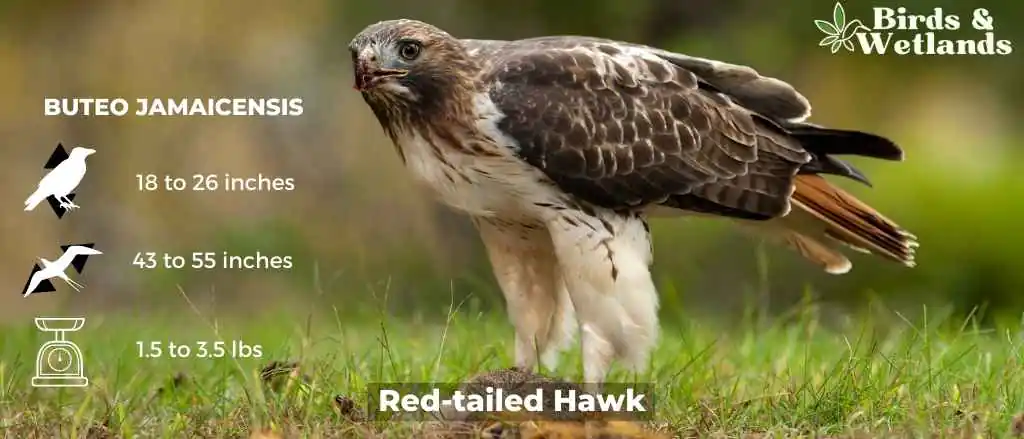
The Red-tailed Hawk is a large bird of prey that is commonly found across North America. This species is part of the genus Buteo, which is often referred to as the “true hawks,” and includes more than two dozen species of raptors.
Red-tailed Hawks have a robust size, ranging from 18 to 26 inches in length and sporting a wingspan that can exceed 4 feet. They have a broad, rounded set of wings and a short, wide red tail. This species is most easily recognized by its rich, rust-colored tail, which gives it its common name. However, juvenile hawks might not yet have this distinctive feature.
Their feathers are generally dark brown on their dorsal side (back) with a lighter, often speckled, ventral side (front). The intensity and pattern of their plumage can vary significantly based on their age and geographic location, as there are about 14 recognized subspecies of Red-tailed Hawks.
As for their diet, Red-tailed Hawks are carnivores and have a broad diet that includes rodents, ground rabbits, reptiles, and other birds. They are skilled hunters that typically sit on high perches and use their keen eyesight to spot potential prey. Once they have identified a target, they swoop down to capture it with their powerful talons.
Red-tailed Hawks mate for life and build nests high off the ground, often in tall trees or on cliff edges. Their nests are made of sticks and can be quite large. They typically lay 1-3 eggs per year, which are incubated by both parents.
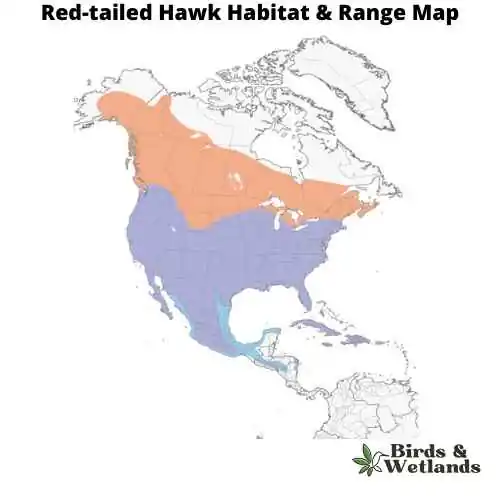
Red-tailed Hawk Sound
Sharp-shinned Hawk (Accipiter striatus)
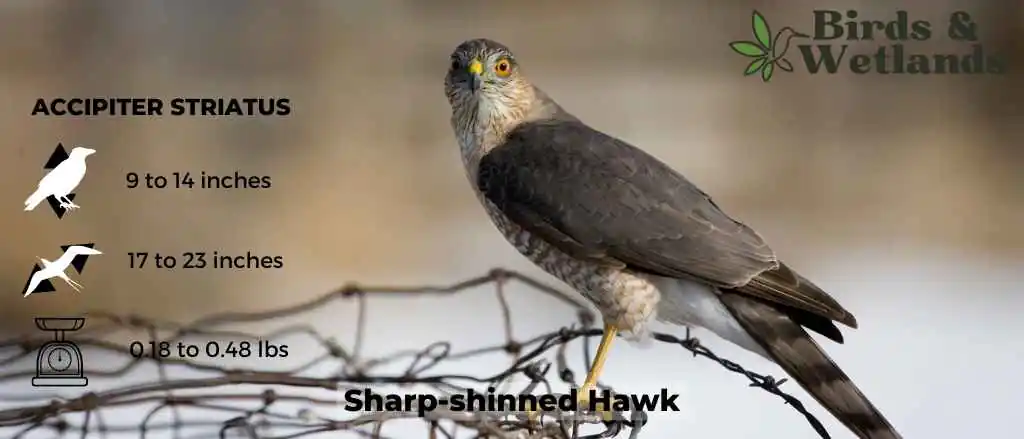
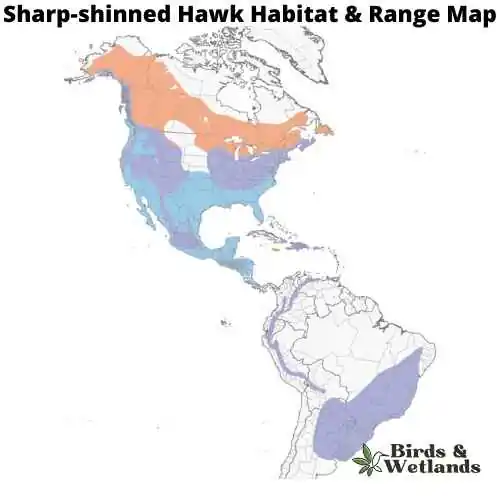
Listen:
The adult bird is brown on top and white underneath, with a dark brown band across its chest. It has short, rounded wings and a long tail that makes it look larger than it actually is. Adult sharp shinned hawks have black eyes, which are surrounded by white feathers. The female Sharp-shinned Hawk is browner than the male, who has darker brown markings on his back.
Sharp-shinned Hawks prefer open country for their habitat, including fields and meadows where they can hunt for mice and other small animals. They can be found throughout the United States but are most common in the east.
Sharp-shinned Hawks eat mostly small birds, such as sparrows and warblers, as well as small mammals such as mice and gophers. They catch prey by surprise using their incredible speed and agility, diving out of the sky at speeds up to 200 mph.
Sharp-shinned Hawks have an unusual hunting style for hawks—they prefer to catch their prey from perches above trees or telephone wires, rather than swooping down from above like most other hawks do and can often be seen hunting near bird feeders.
Cooper’s Hawk (Accipiter cooperii)
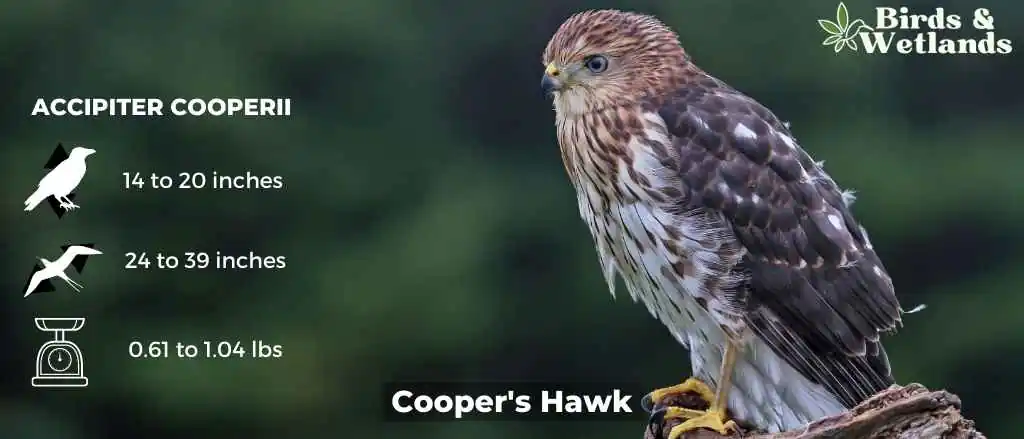
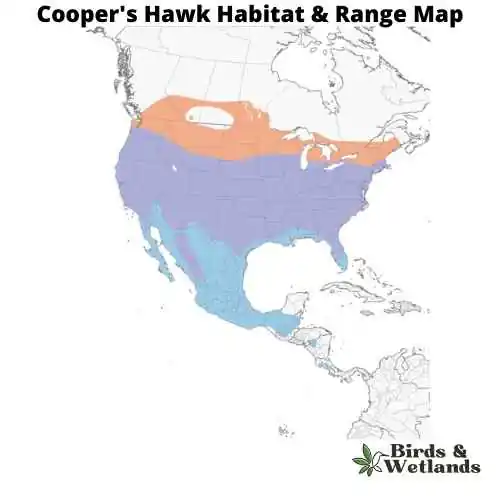
Listen:
The Cooper’s Hawk is a medium-sized bird of prey native to North America. Known for its agility and speed, it is part of the Accipitridae hawk species, which also includes other hawks, eagles, and kites.
Cooper’s Hawks are typically about 14 to 20 inches in length, with a wingspan ranging from 27 to 36 inches. They are known for their distinctive long, rounded tails and short, rounded wings. They have a steely blue gray top, with rusty bars on their underparts and thick, dark bands on their tails.
The Cooper’s Hawk is a skilled predator, primarily hunting birds and small mammals. They are adept at hunting in both dense forests and open areas, often catching prey mid-air in high-speed pursuits. They have also been known to visit the backyard bird feeder, not for the seed, but to prey on the smaller birds that gather there.
Cooper’s Hawks often build nests in dense tree canopies where they are well concealed. The female usually lays 3 to 5 eggs, and both parents share incubation duties. The young hawks fledge after about a month but will stay close to the nest, relying on their parents for food as they learn to hunt.
Red-shouldered Hawk (Buteo lineatus)

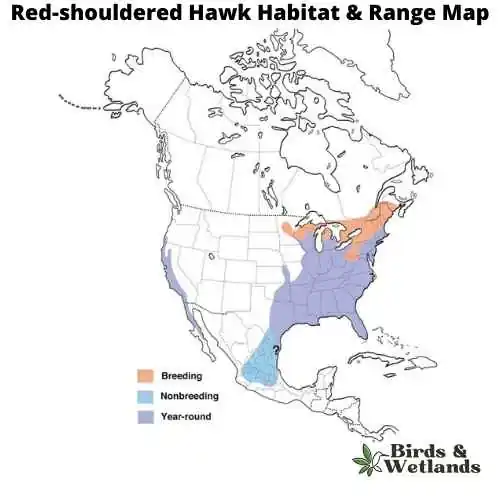
Listen:
The red-shouldered hawk are medium sized birds of prey, part of the buteo hawks family. It can be distinguished from other hawks by its reddish iris and pale legs.
The adult has rusty red upperparts, white underparts, a black chin and throat, and a reddish brown stripe over each eye, reddish brown heads and a strongly banded tail. The tail is reddish brown with two paler bands across it and they have white checkered wings. Juveniles are brown with dark barring and have pale fringes on the feathers of their wings.
Red-shouldered hawks nest in trees, though they also inhabit manmade structures including barns, bridges, and buildings. They prefer wooded areas with an open canopy but will use other places as well for nesting such as shrubs and hedges if needed.
The red-shouldered hawk’s diet – they eat small mammals such as ground squirrels, rabbits, voles, mice and rats. They also eat birds such as quail, pigeons and doves; reptiles including snakes; amphibians; fish; crustaceans; insects; and carrion (dead animals).
Broad-winged Hawk (Buteo platypterus)
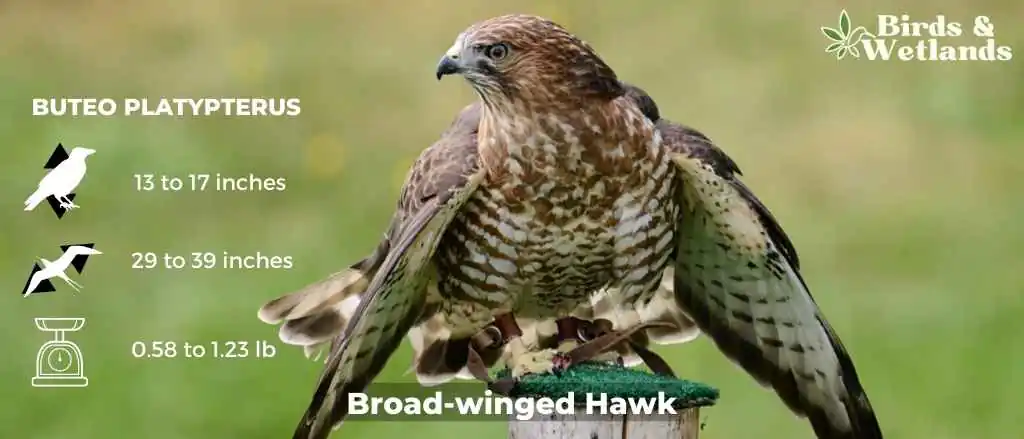
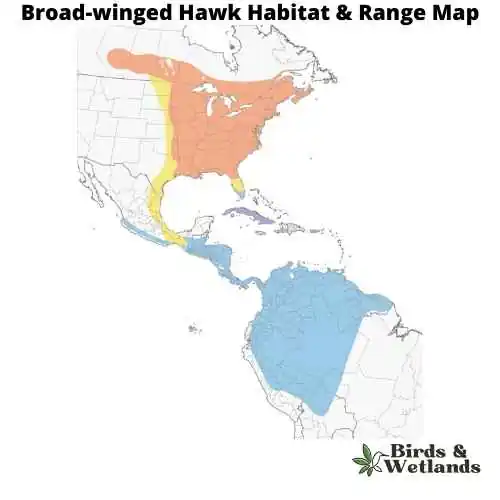
Broad-winged Hawk Sound
The Broad-winged Hawk holds a commanding presence as one of the largest hawks in the world, known for its broad wings. Its formidable size is a testament to its prowess as a bird of prey, effortlessly navigating the open skies in search of food.
Their distinctive appearance sets them apart. The adults exhibit a striking black and white pattern, complemented by a rusty breast and buff underparts and brown wings. In contrast, juveniles are adorned with a brown plumage, marked by pale edges on their feathers, adding to their distinctive youthful charm.
These hawks are most commonly found in open areas, such as farmlands or grasslands interspersed with scattered trees, which provide optimal conditions for when hawks hunt.
When it comes to their diet, Broad-winged Hawks feed on small rodents like mice, rats, squirrels, rabbits, and voles. Broad winged hawks breed during the spring and summer months then migrate to central and south America.
Osprey (Pandion haliaetus)
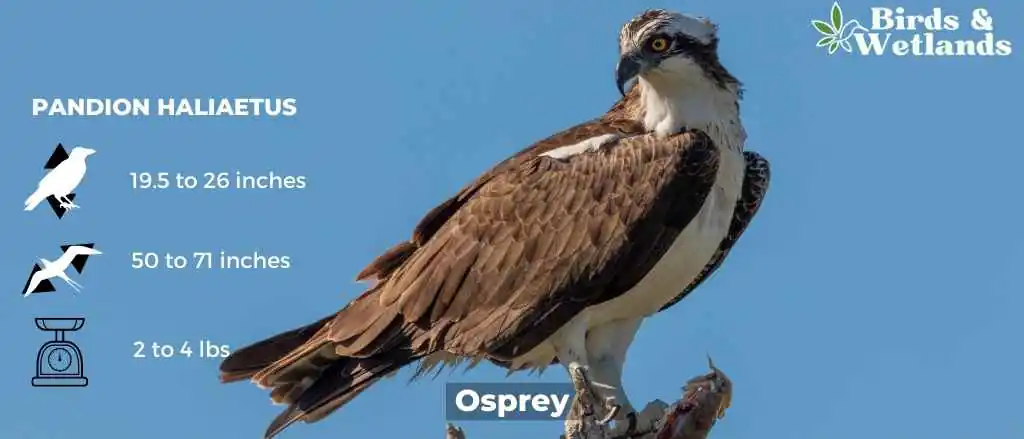
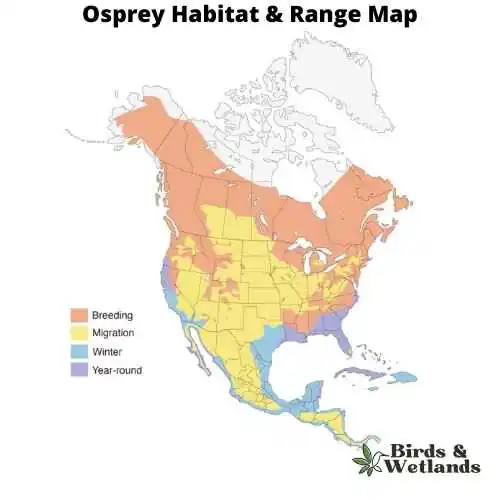
Osprey Sound
Scientific Name: Pandion haliaetus
Length: 50–66 cm (19+1⁄2–26 in)
Wingspan: 127–180 cm (50–71 in)
Weight: 0.9–2.1 kg (2 lb 0 oz – 4 lb 10 oz)
The Osprey, a fascinating bird of prey, is universally known for its exceptional hunting prowess and striking physical characteristics. Osprey are dark brown hawks on the upperparts, contrasting beautifully with the predominantly white underparts, and a distinctive dark band that stretches across the eyes towards the sides of its head.
Equipped with specialized talons and a reversible outer toe, the Osprey’s hunting strategy involves a spectacular plunge-dive into bodies of water, often emerging with a fish securely gripped in its claws.
Found on every continent except Antarctica, the Osprey is a cosmopolitan species favoring habitats near water bodies such as lakes, rivers, and coastal areas, reflecting its piscivorous diet. This bird has a diet almost exclusively of fish, making it a unique member of the raptor family and often referred to as the sea hawk or fish hawk. They locate their prey from the air, often hovering before plunging feet-first to capture a fish. When it comes to breeding, Ospreys are monogamous, often mating for life.
They construct large, bulky nests made of sticks, lined with softer materials, and prefer elevated or isolated areas such as treetops or artificial structures like utility poles. Both parents share the responsibility of incubating the eggs and rearing the chicks.
Great Horned Owl (Bubo virginianus)
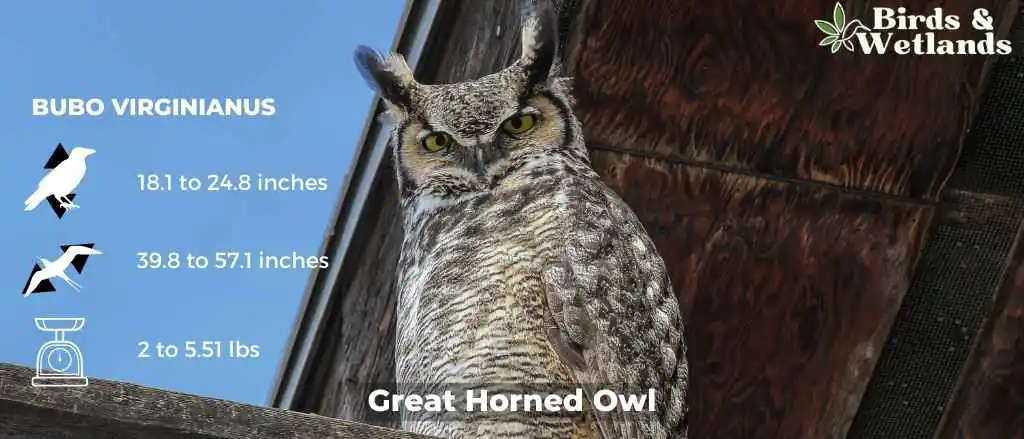

Great Horned Owl Sound
Scientific Name:Bubo virginianus
Length: 18.1-24.8 in
Wingspan: 39.8-57.1 in
Weight: 32.1-88.2 oz
The Great Horned Owl is a large owl with long wings and a large head. It’s one of the most common owls in North America.
Great Horned Owls are large, stocky birds with soft feathers that are gray to brown on their backs and white on their chests. Their faces are characterized by two black “ear” tufts, which can be raised or flattened depending on the owl’s mood. The eyes are yellow, orange, or red in color.
The habitat of the Great Horned Owl is a variety of different environments such as forests and deserts. They also live near water sources such as lakes, streams and rivers where they can hunt for fish.
The diet of the Great Horned Owl consists primarily of small mammals such as mice and rats; however they will also eat other rodents such as squirrels, rabbits and porcupines. They have been known to eat skunks too.
Barred Owl (Strix varia)
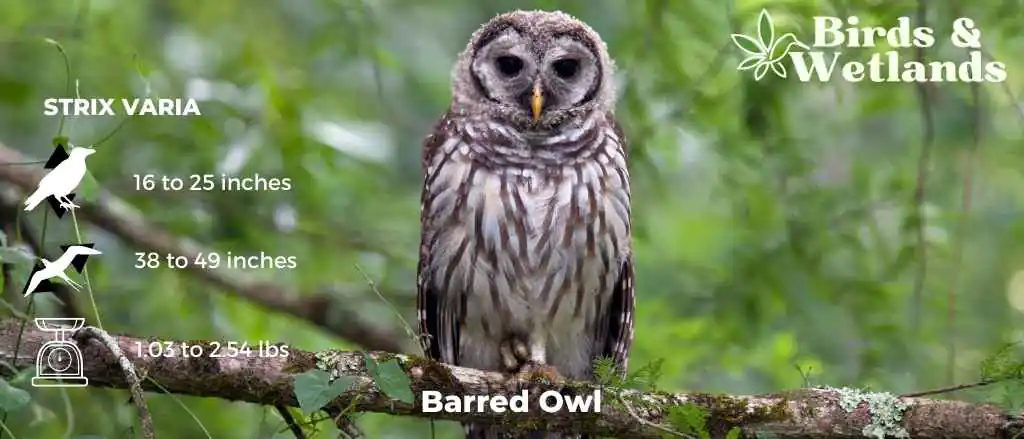

Barred Owl Sound
Scientific Name: Strix varia
Length: 40 to 63 cm (16 to 25 in)
Wingspan: 96 to 125 cm (38 to 49 in)
Weight: 468 to 1,150 g
The Barred Owl is a medium-sized owl with a barred pattern on its chest and belly. They have large yellow eyes that allow them to see well in low light conditions. Their ears are not very large which means they do not hear very well but they have excellent hearing abilities which allow them to detect sounds up to 1 mile away. Their feathers are brown and streaked with white, and they have black bars on their chests and wings.
Their habitats include forests, woodlands, orchards, parks, farmland and suburban backyards.
Barred Owls (also known as hoot owl) eat small mammals such as mice, rats and squirrels. They also eat insects such as beetles or grasshoppers. These owls hunt during the day when it is light out so that they can see their prey better than at night when they would be using senses other than sight like sound or smell to find their food source.
Barred owls are monogamous birds which means they mate for life. They build nests in trees or cavities on the ground and lay 2-4 eggs per year. The incubation period for these eggs lasts about 28 days before hatching takes place.
Eastern Screech-Owl (Megascops asio)
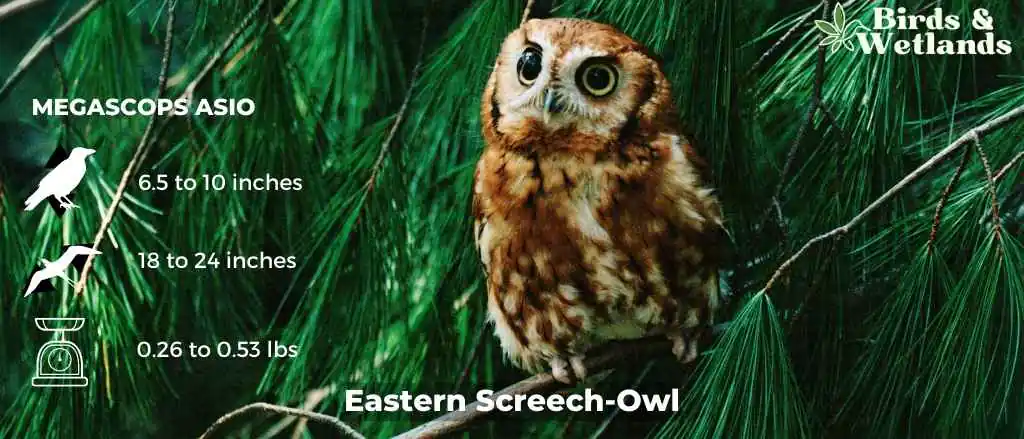
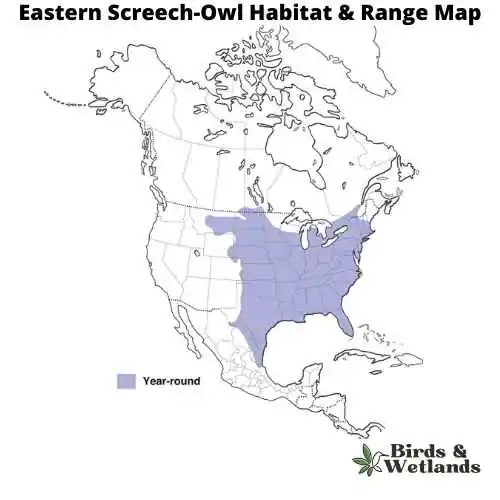
Eastern Screech-Owl Sound
Scientific Name: Megascops asio
Length: 6 to 10 in
Wingspan: 8 to 24 in
Weight: 4 – 8.5 oz
The Eastern Screech-Owl is a small owl species native to most wooded environments of the eastern half of North America, from the Canadian provinces to Florida and Texas.
Eastern Screech-Owls are relatively small and exhibit a complex pattern of gray or reddish-brown coloration, which provides excellent camouflage against tree bark.
These owls are known for their distinctive call, which is often described as a haunting trill or a whinny-like sound. Despite their name, they do not actually produce a “screech.”
Eastern Screech-Owls feed on a variety of prey, ranging from small mammals and birds to insects and even earthworms. It is primarily nocturnal, hunting at night from a low perch and swooping down onto prey.
Eastern Screech-Owls nest in tree cavities or abandoned woodpecker nests, but they readily adapt to nesting boxes where natural cavities are not available. They typically lay between 2 to 6 eggs, which are incubated primarily by the female.
Barn Owl (Tyto alba)

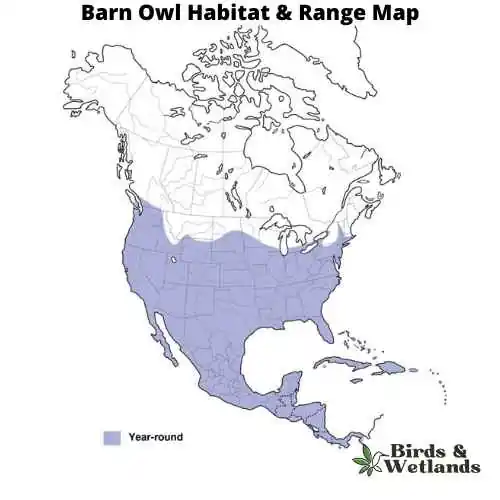
Barn Owl Sound
Scientific Name: Tyto alba
Length: 13 to 15 in
Wingspan: 31 to 37 in
Weight: 9.2 oz
The Barn Owl is a widespread species of owl known for its distinctive heart-shaped facial disc.
Barn Owls are medium-sized owls, they are pale overall with golden-brown wings and back, contrasted by a white face, chest, and belly. Their most notable feature is their heart-shaped facial disc, which helps channel sound to their ears.
Barn Owls are typically found in open habitats, including farmland, woodland, and marshes. They are named for their habit of nesting in human structures such as barns, church towers, and in the hollows of large trees. These owls are nocturnal, hunting at night and roosting during the day.
The diet of Barn Owls primarily consists of small mammals, particularly rodents such as mice and rats. They are known for their silent flight, which allows them to sneak up on their prey without detection.
Barn Owls have a unique nesting behavior. They do not build nests, but instead, lay their eggs directly on the bare surface of a secluded ledge or cavity. A female typically lays 4-7 eggs, and both parents help incubate the eggs and care for the chicks.
Short-eared Owl (Asio flammeus)
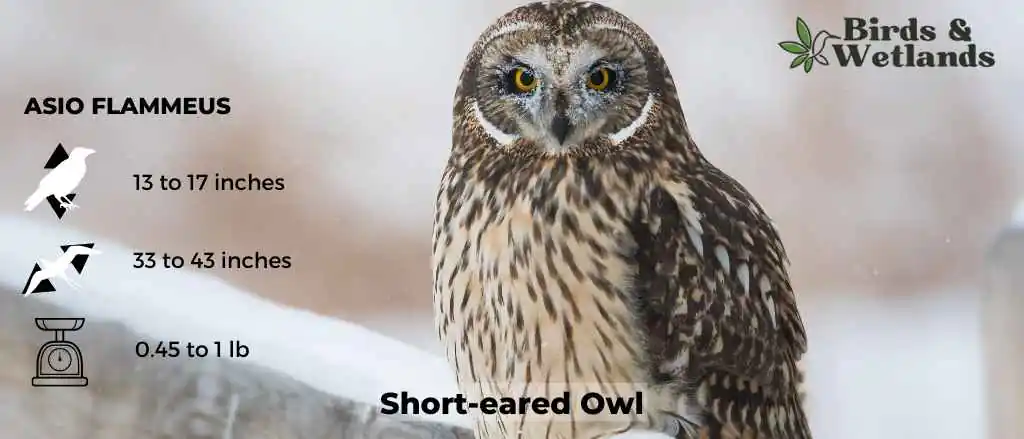
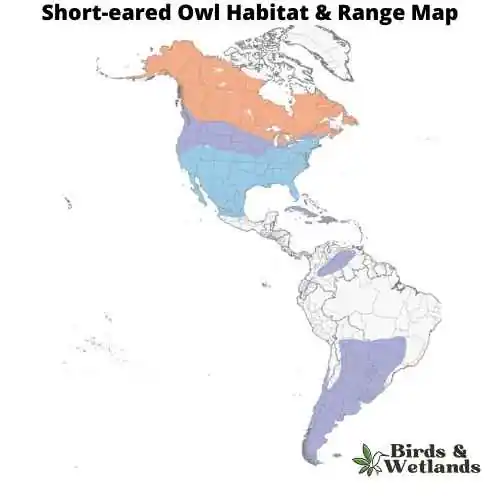
Short-eared Owl Sound
Scientific Name: Asio flammeus
Length: 13–17 in
Wingspan: 33 to 43 in
Weight: 7.3–16.8 oz
The Short-eared Owl is a medium-sized owl species with a wide distribution, found across North and South America, Europe, Asia, and many Pacific islands. Despite its name, the “ears” of the Short-eared Owl are not often visible, as they are small and tend to blend with the bird’s feathers.
The owls are predominantly brown with buff and white accents throughout their body and wings, and dark patches around their yellow eyes.
Short-eared Owls diet consists largely of small mammals, especially voles. However, they are opportunistic hunters and will also prey on a variety of other animals, including other birds, when available.
Their habitat is characterized by open areas like grasslands, marshes, and tundra. They nest on the ground, which is unusual for owls, and this makes them vulnerable to ground predators. As such, they often live in areas with tall grasses or other ground cover for protection.
Peregrine Falcon (Falco peregrinus)


Peregrine Falcon Sound
Scientific Name: Falco peregrinus
Length: 14.2-19.3 in
Wingspan: 39.4-43.3 in
Weight: 530-1600 g
Known for its blue-gray plumage and unique cheek bars, the Peregrine Falcon stands as a beacon of power and swiftness. Despite its modest size, it reigns as the world’s fastest creature, reaching staggering speeds up to 240 mph during hunting dives.
Its diet mainly includes birds, occasionally bats, caught in an enthralling aerial display of agility and precision. Adapting to diverse habitats, this bird graces every continent except Antarctica, finding home in environments from city skyscrapers to towering cliffs.
Peregrine Falcons, monogamous in nature, often pair for life, expressing their bonds through complex courtship flights filled with intricate aerial maneuvers. They construct simple scrape nests on high ledges, often without adding materials.
Their parenting duties are shared, from egg incubation to feeding and caring for the chicks, ensuring their offspring are ready to take on the skies in their own time.
American Kestrel (Falco sparverius)


American Kestrel Sound
Scientific Name: Falco sparverius
Length: 8.7 to 12.2 in
Wingspan: 20–24 in
Weight: 3.0–5.8 oz
The American Kestrel, often recognized as the smallest and most brightly colored falcon in North America, exhibits a stunning array of rufous, blue and gray hues in its plumage. This bird, ranging in size from a mere 22 to 31 cm, carries distinct black facial markings that contrast with its white cheeks and has blue gray wings. Despite its small stature, the American Kestrel is a formidable predator, employing a unique hunting strategy that involves hovering at a height before swooping down on prey, primarily consisting of insects, small mammals, and occasionally small birds.
Residing predominantly in North and South America, the American Kestrel exhibits a preference for open habitats such as meadows, grasslands, and deserts. They are also found in both urban and suburban environments, nesting in cavities in trees, cliffs, buildings, and other structures. Kestrels are monogamous, with both sexes participating in the courtship displays that involve aerial acrobatics and feeding rituals. Nesting duties are a shared responsibility, with the male initially scouting for suitable locations and the female making the final selection. Both parents contribute to the incubation of the eggs and care of the young, ensuring the perpetuation of this captivating species.
Bald Eagle (Haliaeetus leucocephalus)

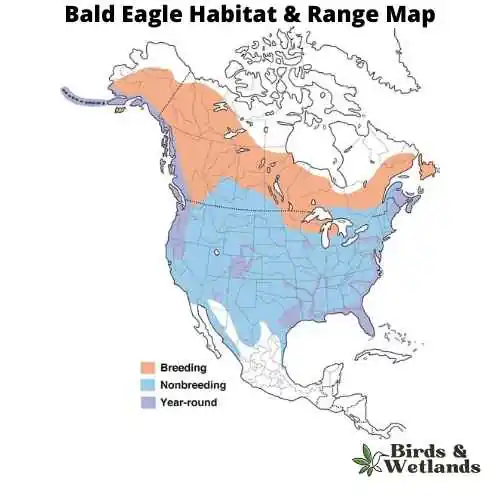
Bald Eagle Sound
Scientific Name: Haliaeetus leucocephalus
Length: 28–40 in
Wingspan: 5 ft 11 in and 7 ft 7 in
Weight: 6.6 -13.9 lb
The Bald Eagle, primarily found in Canada and Alaska, is instantly identifiable by its white head, dark brown body, yellow beak, and a piercing cry. Its sharp, orange-yellow eyes aid in efficient night hunting.
Predominantly residing in North America, occasionally venturing into Asia and Europe, it thrives near water bodies. It perches atop trees, providing a bird’s-eye view of its prey. It feeds on fish, carrion, small mammals like rabbits and squirrels, and reptiles. Hunting involves a swift downward swoop to seize the prey, carrying it back to the nest.
Bald Eagles are monogamous, forming lifelong pairings. They construct vast nests from sticks, lined with moss or grasses. They typically lay 1-3 eggs annually, which hatch around 35 days later. The fledglings leave the nest roughly 6 weeks after hatching, but continue to rely on their parents for nourishment for a further 5-6 months, until they become proficient hunters.
Turkey Vulture (Cathartes aura)


Turkey Vulture Sound
Scientific Name: Cathartes aura
Length: 24–32 in
Wingspan: 63–72 in
Weight: 1.8 to 5.3 lb
Turkey vultures are large birds that are easily recognizable by their bald heads, which are black in coloration, and by the patch of red skin below their beaks. It is white with black spots on the wings and tail. It has a bald head and a hooked beak that is black in coloration.
Turkey vultures live in the Americas, Europe, Africa, and Asia. They can be found in deserts, grasslands, forests and swamps. Turkey vultures are found throughout North America and parts of Central America and South America. In the U.S., they can be found across the country, but most commonly in the southwest region.
Turkey vultures eat carrion—dead animals’ remains such as dead deer, sheep, cows, horses and other large mammals that have been killed by other predators, such as coyotes or foxes. They do not hunt live prey.
The Black Vulture (Coragyps atratus)
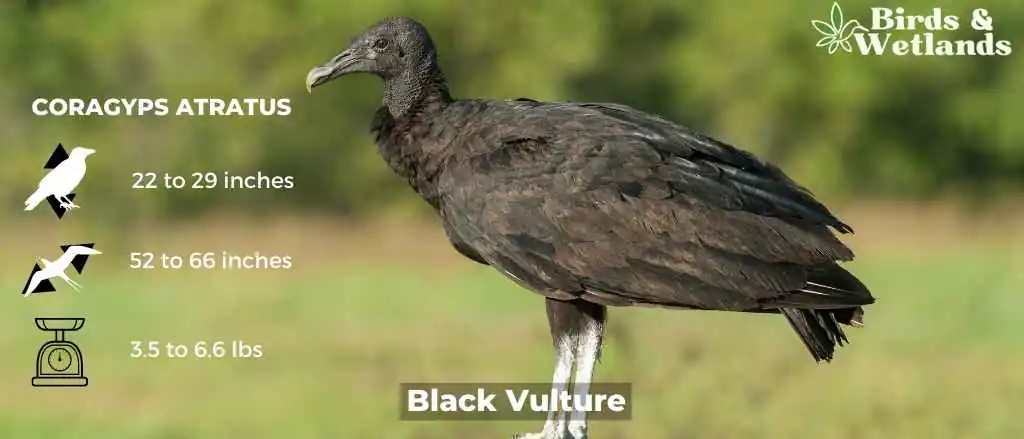

Black Vulture Sound
Scientific Name: Coragyps atratus
Length: 22–29 in
Wingspan: 52–66 in
Weight: 3.5 to 6.6 lb
The Black Vulture is easily recognizable by their black plumage, short, square tail, and their bald black head.
These birds are scavengers and play a vital role in the ecosystem by feeding primarily on carrion (dead animals). They are known to occasionally kill smaller, weakened animals, but such behavior is not the norm. Black Vultures locate food using their excellent sense of sight and by following other vultures.
Unlike most birds, Black Vultures are not known to build traditional nests. Instead, they lay their eggs in sheltered areas like hollow trees, abandoned buildings, or thickets. They typically lay two eggs, and both parents will incubate and care for the chicks.
Black Vultures are social birds that are often seen in large groups. They roost together in large numbers and are known to even forage in groups. They can often be seen soaring on thermals during the day, hardly flapping their wings, while looking for food.
Where to Spot Georgia’s Birds of Prey
Chattahoochee River National Recreation Area, Sandy Springs: Located in the heart of the Atlanta metro area, this national park is an excellent place to spot several species of raptors. Look for Red-tailed Hawks, Cooper’s Hawks, and Peregrine Falcons among the tall trees and along the riverbanks.
Okefenokee National Wildlife Refuge, Folkston: This 402,000-acre refuge is a haven for birds of prey. The mix of swampland and forests provides a habitat for Bald Eagles, Ospreys, and various species of hawks and owls. Canoe trails and boardwalks allow for closer observation of these creatures.
Cumberland Island National Seashore, St. Marys: Known for its pristine beaches and diverse ecosystems, Cumberland Island is also a hotspot for birdwatching. You may spot Ospreys, Northern Harriers, and Peregrine Falcons, particularly during the migration season.
Cohutta Wildlife Management Area, Chatsworth: Located in the heart of the Appalachian Mountains, this area offers a great diversity of raptors due to its rich forest habitats. It’s a prime location for viewing owls, hawks, and even the occasional Bald Eagle.
Jekyll Island, Golden Isles: This coastal location is home to diverse habitats that attract a variety of birds. Hawks, ospreys, and even the occasional Peregrine Falcon can be seen here, particularly around the island’s marshes. The island’s Migratory Bird Journey also hosts several bird-related events and activities.
In Georgia, the symphony of nature includes the calls of various raptors. Experience the tenacity of South Carolina’s Birds of Prey, resonating with the state’s palmetto-laden landscapes. Alternatively, uncover the wild allure of Alabama’s Feathered Hunters, which mirror the state’s diverse natural beauty. Learn more about these birds with our comprehensive Birds of Prey Guide.

